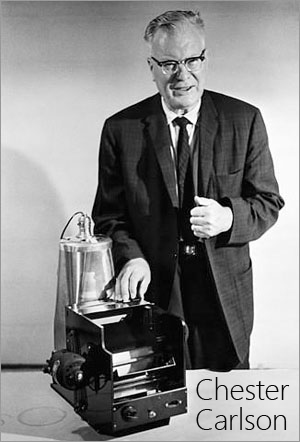HOW DOES A COPIER WORK?
 Believe it or not, the modern copier in your office relies on technology that is not all that different from that used in much earlier copiers.
Believe it or not, the modern copier in your office relies on technology that is not all that different from that used in much earlier copiers.
Today it’s referred to as the xerographic process, but when Chester Carlson invented it in 1938, he called it electrophotography.
Carlson, a physicist and inventor, developed electrophotography based on two scientific facts:
1) materials of opposite electrical charges attract
2) some materials become better conductors of electricity when exposed to light
Leveraging these two physical certainties, Carlson invented a multi-step process that allowed the transfer of an image from one surface to another.
First, a light-sensitive surface called a photoreceptor, usually a thin layer of photoconductive material applied to a flexible belt or drum, is charged by applying a strong electric current to it. This produces an electric field which causes the adjacent air molecules to ionize. Ion molecules that are the same polarity as the voltage stick to the photoreceptor’s surface, creating an electric field across it.
The photoconductive surface is then exposed to the image of a document. On the older analog machines, reflected light from an illuminated image was projected onto the photoreceptor. Today’s digital copiers use modulating lasers or light-emitting-diodes instead. As a result, the areas of the photoreceptor that have been exposed to light lose their charge, while the dark areas retain their charge.
Negatively charged powder, which is a mixture of colorant and plastic resin called toner, is spread over the surface and adheres through triboelectricity – also known as static electricity – to the positively charged image areas. Color documents are created on separate C, M, Y and K (cyan, magenta, yellow and black) xerographic units and then superimposed over one another.
A piece of paper is placed over the xerographic surface and its powder image and given a positive electrical charge. The charge must be strong enough to overcome the powder’s adhesion to the photoreceptor, causing it to release and stick to the paper’s surface. A second charge then releases the paper from the photoreceptor. The paper is then passed through two rollers where heat and pressure are applied, causing the toner to melt and bond with the paper, producing a copy of the original image.
Technological advancements have improved the way copiers work, but if Mr. Carlson were alive today and peeked inside your copier, he’d still see something familiar.
Return to the Tech Trends Newsletter

